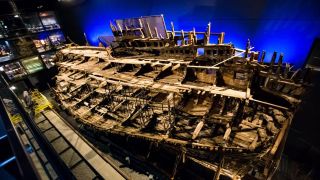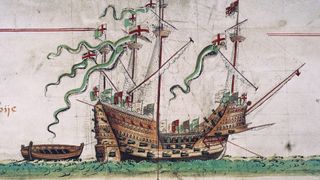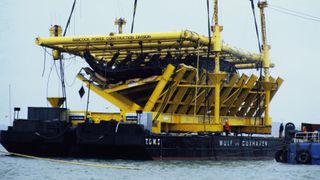Henry VIII's favorite ship has a bacteria problem, and now scientists have ID'ed the culprits
The Mary Rose sank in the 16th century during the Battle of the Solent.

Powerful X-rays have revealed what's eating the wreck of King Henry VIII's favorite warship, the Mary Rose. After the ship sank in a 1545 battle against the French, sulfur-producing marine bacteria spent the next few centuries munching on the wood of the submerged wreck, leaving behind residues that could turn to acid when exposed to air and harm the historic shipwreck today, researchers recently discovered.
The Mary Rose — what was left of it — languished at the bottom of the English Channel until the ship was raised in 1982, and though conservators took steps to treat and preserve the waterlogged structures, little was known about the bacterial species inhabiting the wood and if their byproducts could jeopardize the rescued ship's preservation.
By combining X-rays with a technique that compares atoms of molecules in the ship's wood, scientists detected acid-forming nanoparticles that were byproducts of destructive bacteria. Identifying and pinpointing the location of acid-forming compounds that could erode the ship, will help conservators to protect this one-of-a-kind artifact.
Related: Sunken treasures: the curious science of 7 famous shipwrecks
This novel method "allows us not only to image and locate these nanoparticles in Mary Rose wood, but also to evaluate their structure," said study lead author Serena Cussen, head of the Department of Materials Science and Engineering at the University of Sheffield in the U.K..
"This is the first time zinc sulfide nanostructures — the bacterial byproducts — have been observed in Mary Rose wood," Cussen said in a statement. Previously, scientists were unable to get such a highly detailed view of potentially harmful bacteria species, she added.
When King Henry VIII ordered the construction of the Mary Rose in 1510, he was just 19 years old and had assumed the throne one year earlier. At the time, the Mary Rose was a "state-of-the-art" warship capable of carrying up to eight large guns and weighing about 600 tons (544 metric tons), according to the Mary Rose Trust in Portsmouth, U.K. The Mary Rose sailed in two wars against France before capsizing — "for reasons unknown" — during a battle against the French armada, and it sank to the ocean bottom along with a crew of about 500, according to the Trust.
Sign up for the Live Science daily newsletter now
Get the world’s most fascinating discoveries delivered straight to your inbox.

Divers discovered the Mary Rose in 1971 in the Solent, a strait between Great Britain and the Isle of Wight (an island in the English Channel, and a county in England); and over the next decade, more than 500 divers and researchers helped to excavate the vessel, removing individual artifacts one at a time. Then, in 1982, a team of experts raised the ship's hull, about half of which was still intact. It was treated with polyethylene glycol (PEG), a compound for stabilizing water-saturated wood and preventing shrinkage as the wood dries, scientists wrote in a new study.
However, even after being treated, waterlogged wood can still be vulnerable to deterioration. Plenty of sulfur-producing bacteria can still lurk in the wood, and as PEG breaks down over time, it too can generate harmful acids, according to the study.
"There are potentially several tons of sulfur-containing species, as well as PEG breakdown products, residing in the Mary Rose hull, highlighting the magnitude of this problem," the authors reported.

They sampled a 2-inch-long (5 centimeters) wood core from the Mary Rose's hull, slicing the sample into smaller pieces for analysis with X-rays and scanning electron microscopy (SEM). When the scientists compared scattering patterns in the data based on the atomic structures of compounds in the wood, they were able to detect iron sulfide-based nanostructures, which are produced by bacteria and can form harmful acids when they interact with oxygen.
"What our results have done is alert conservators to these previously unknown deposits and expand the study of degradation-inducing materials," Cussen said in the statement. "Knowing the structure of these potentially harmful species also allows us to design targeted treatments for their future removal."
The findings were published Oct. 27 in the journal Matter.
Originally published on Live Science.

Mindy Weisberger is an editor at Scholastic and a former Live Science channel editor and senior writer. She has reported on general science, covering climate change, paleontology, biology, and space. Mindy studied film at Columbia University; prior to Live Science she produced, wrote and directed media for the American Museum of Natural History in New York City. Her videos about dinosaurs, astrophysics, biodiversity and evolution appear in museums and science centers worldwide, earning awards such as the CINE Golden Eagle and the Communicator Award of Excellence. Her writing has also appeared in Scientific American, The Washington Post and How It Works Magazine.
